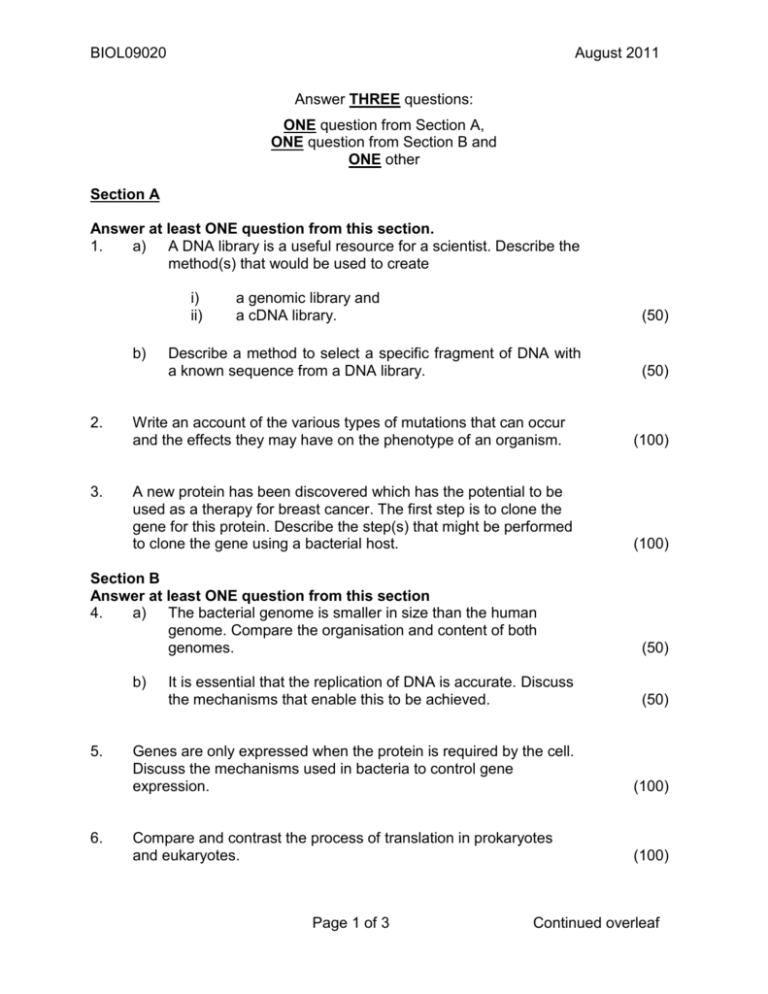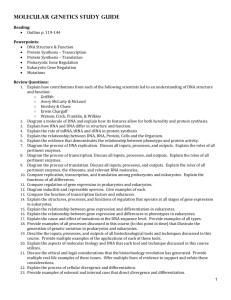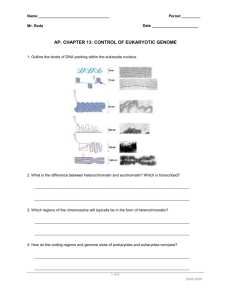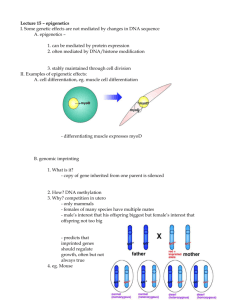2011 Jan-May
advertisement

BIOL09020 August 2011 Answer THREE questions: ONE question from Section A, ONE question from Section B and ONE other Section A Answer at least ONE question from this section. 1. a) A DNA library is a useful resource for a scientist. Describe the method(s) that would be used to create i) ii) b) 2. 3. a genomic library and a cDNA library. (50) Describe a method to select a specific fragment of DNA with a known sequence from a DNA library. Write an account of the various types of mutations that can occur and the effects they may have on the phenotype of an organism. (100) A new protein has been discovered which has the potential to be used as a therapy for breast cancer. The first step is to clone the gene for this protein. Describe the step(s) that might be performed to clone the gene using a bacterial host. (100) Section B Answer at least ONE question from this section 4. a) The bacterial genome is smaller in size than the human genome. Compare the organisation and content of both genomes. b) 5. 6. (50) (50) It is essential that the replication of DNA is accurate. Discuss the mechanisms that enable this to be achieved. (50) Genes are only expressed when the protein is required by the cell. Discuss the mechanisms used in bacteria to control gene expression. (100) Compare and contrast the process of translation in prokaryotes and eukaryotes. (100) Page 1 of 3 Continued overleaf BIOL09020 August 2011 Section A Answer at least ONE question from this section. 1. a) In gene cloning both the ligation step to create the recombinant DNA and the transformation of bacteria with recombinant DNA are inefficient. Discuss both the reasons why and also any techniques that improve the efficiency. b) 2. 3. Describe two ways that bacteria transformed with recombinant DNA can be separated from untransformed or vector only transformed cells. (50) (50) Discuss both the underlying mechanistic principle and some of the uses of the polymerase chain reaction (PCR). (100) Write an account of the effects of genomic mutations with reference to specific diseases (100) Section B Answer at least ONE question from this section. 4. A protein, called DBP50, has been isolated from cells. The presence of this protein in the cell results in increased expression of gene C. Structural studies have shown DBP50 to have a zinc finger motif. 5. 6. a) Discuss the possible role of the protein, DBP50, in the cell. (20) b) Discuss possible experiments that would give more information about DBP50 and its relationship with gene C. (80) Compare and contrast the control of gene expression in prokaryotes and eukaryotes. (100) Outline the mechanisms of DNA replication and repair. (100) Page 2 of 3 Continued overleaf BIOL09020 August 2011 SECTION A Answer at least ONE Question from this section Q1 a) A genomic library is a useful resource for a molecular biologist. Outline the methods that can be used to create a genomic library and how a library might be used to study genes. (50) b) Compare and contrast the two types of DNA library that are commonly used, namely genomic and cDNA libraries. (50) Q2 As a researcher you have been asked to clone the gene which codes for a detoxification enzyme the group are working on. Describe the method you would use to clone this gene using Esherichia coli as a host. (100) Q3. ‘Gene mutations can lead to cancer.’ Using specific examples discuss this statement. (100) SECTION B Answer at least ONE Question from this section Q4 a) The human genome contains many repetitive sequences. Describe how these can be used to identify individuals. (50) b) Describe the role of the enzyme telomerase in both normal and cancerous cells. (50) Q5 Compare and contrast the process of transcription in prokaryotes and eukaryotes. (100) Q6 Outline the structure of the lac operon of Escherichia coli and describe the mechanism by which the operon is regulated in response to the availability of lactose. (100) Page 3 of 3 Continued overleaf









